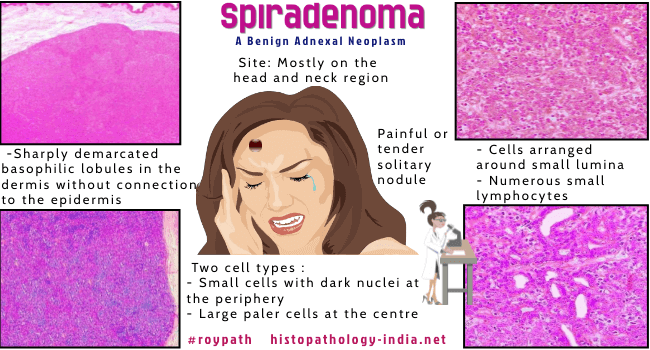|

Custom Search
|
|
Dermpath-India Pathology of Spiradenoma Dr Sampurna Roy MD 2022
|

 |
|
Spiradenoma is a rare benign adnexal tumour
occuring in adults.
This lesion often coexists with cylindromas. Clinical presentation: Usually presents as a painful or tender solitary nodule (less than 1cm in diameter). May occasionally present as multiple lesions . Giant variants, linear or zosteriform distribution have also been reported. Site: Head and neck, sometimes on the scalp and on the trunk. Rarely on the extremities.
Malignant transformation of spiradenoma (Spiradenocarcinoma) may occur in rare cases. Brooke-Spiegler syndrome is a rare, autosomally dominant disease characterized by the development of multiple cylindromas, trichoepitheliomas, and occasional spiradenomas. Brooke-Spiegler Syndrome-[Pathology Infographic] Dermatopathology Quiz Case: 153
|
|
Further reading:
Painful eccrine spiradenoma containing nerve fibers: a case report. A case of eccrine spiradenoma in a patient with neurofibromatosis. Eccrine spiradenoma with chondroid syringoma in Blaschkoid distribution. An unusual case of congenital linear eccrine spiradenoma. Eccrine spiradenoma: co-expression of cytokeratin and smooth muscle actin suggesting differentiation toward myoepithelial cells. |
|
|
 |
Copyright © 2002-2022 histopathology-india.net